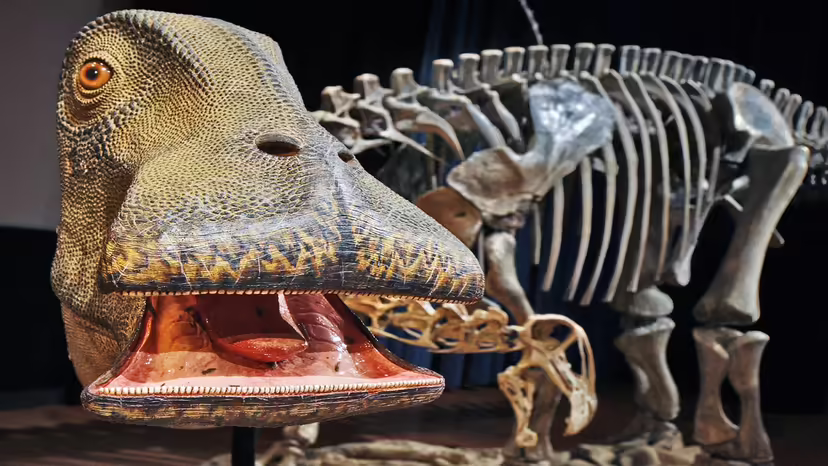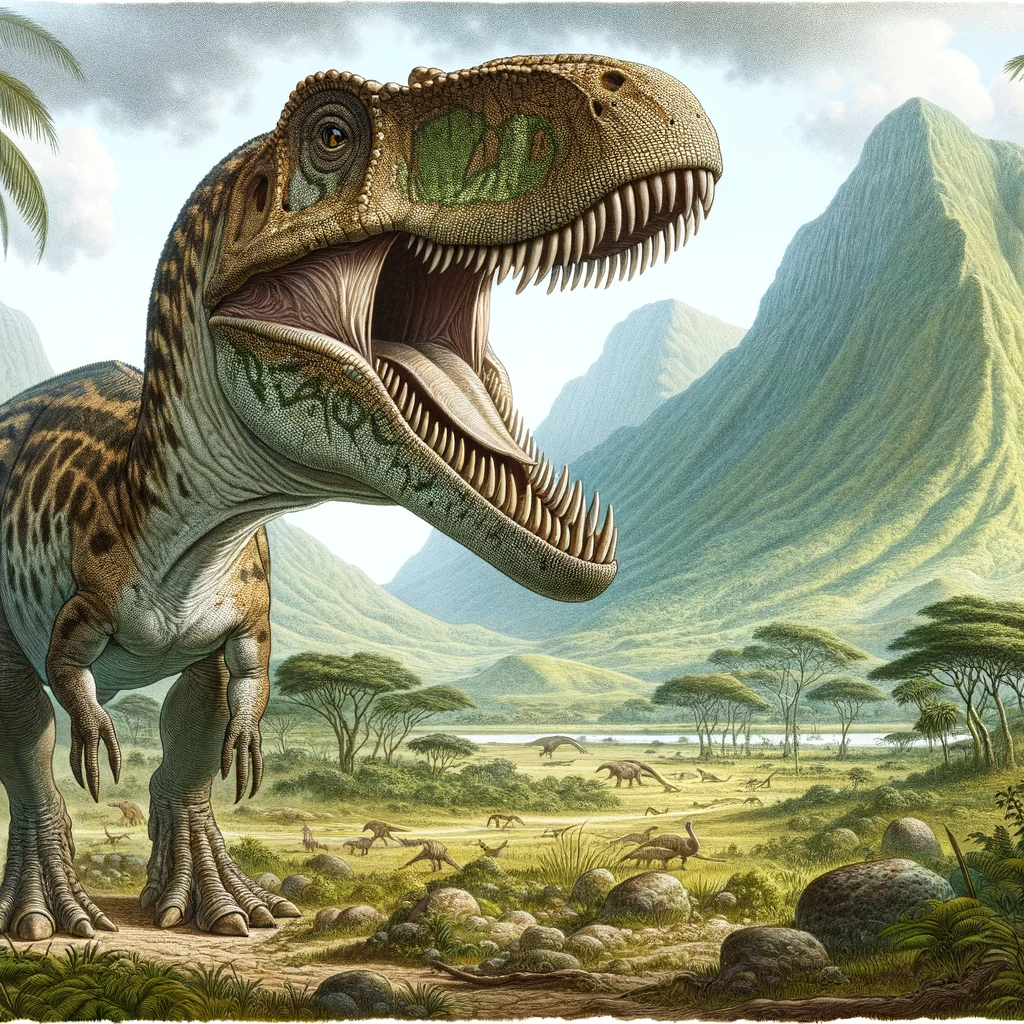
This detailed reconstruction of the Nigersaurus showcases its unique herbivorous features through a combination of artistic sculpture and scientific precision. Offering a view into the dinosaur’s distinctive head structure, the display includes an authentic assembly of bone casts, presenting an engaging look at this ancient creature’s form.
BILL O’LEARY/THE WASHINGTON POST/GETTY IMAGES
The term “Mesozoic Cow” might sound like a punchline lifted straight from a Gary Larson comic strip, but it actually refers to a real dinosaur discovered in Africa, known as Nigersaurus taqueti. This unique name came into the spotlight back in 2007 when fascinating details about this dinosaur’s distinctive appearance were unveiled to the public.
In an interview with NPR during that period, the renowned paleontologist Paul Sereno shared insights into the Nigersaurus, which he affectionately dubbed “the weirdest dinosaur I’ve ever seen.” He intriguingly likened its facial structure to that of a vacuum cleaner, painting a vivid picture of its unusual feeding mechanism.
So, which dinosaur boasted an impressive array of 500 teeth? This unconventional herbivore, the Nigersaurus, roamed the regions of today’s Sahara Desert around 110 million years ago. Belonging to the sauropod family, it featured a remarkably wide mouth, even broader than the back of its head as observed in the original fossil. This peculiar design allowed it to efficiently graze on the ancient vegetation.
Indeed, when it came to dental equipment, the Nigersaurus was exceptionally well-endowed. With a staggering count of 500 teeth, this dinosaur was truly in a league of its own when it came to munching through the Mesozoic era’s lush landscapes.
Nigersaurus Taqueti: A Very Unusual Dinosaur

Referring to an object as “elephant-sized” sets the expectation for something impressively large, perhaps even colossal.
The Nigersaurus, stretching just over 29 feet (about 9 meters) and tipping the scales at an estimated 4.4 tons (around 4 metric tons), matched the dimensions of a contemporary African elephant in sheer bulk.
However, there’s an intriguing twist to consider. The Nigersaurus belonged to the sauropod family, a prominent lineage within the dinosaur world renowned for their herbivorous habits, diminutive heads, and a history that spans approximately 140 million years. This group boasts members that rank among the most gigantic creatures ever to traverse the planet, with the largest recorded species reaching lengths of over 110 feet (about 33.5 meters). It’s not uncommon to find sauropods in the fossil record that measure between 40 to 85 feet (12 to 26 meters).
Despite these figures, the Nigersaurus is considered modest in size compared to its colossal cousins. Yet, what really captured the imagination of many was not its size but rather its distinctive facial structure.
This Sauropod Dinosaur Had 500 Teeth
Paul Sereno’s analogy likening the Nigersaurus to a vacuum cleaner is remarkably apt. When observed from above, the dinosaur’s expansive snout bears an uncanny resemblance to the working end of a vacuum, designed for efficient gathering.
This prehistoric giant boasted a feature unprecedented among its sauropod brethren: its skull was among the earliest to exhibit dental batteries, a sophisticated evolutionary adaptation not involving the common household batteries, but rather a complex, natural mechanism for processing food. These dental batteries consisted of rows upon rows of teeth, vertically arranged and designed to replace themselves. As the foremost tooth in any column wore down, the one directly beneath it ascended to take its place.
Imagine these teeth arranged as tightly as sardines in a can, allowing the dinosaur to host an impressive arsenal of several hundred teeth, both worn and new, within its mouth.
Specifically, the Nigersaurus’ upper jaw was equipped with 60 columns of slender, needle-like teeth, while its lower jaw boasted no less than 68 razor-sharp teeth. Combined, this formidable creature possessed over 500 teeth in total.
While dinosaur researchers frequently encounter dental batteries in beaked herbivores, such as the horned Triceratops or the shovel-billed Edmontosaurus, finding such a feature in sauropods is a rarity, making the Nigersaurus an exceptional specimen in the annals of paleontology.
“Mind If I Browse?”
The configuration of teeth is as critical as their abundance, a fact well understood by anyone who has undergone orthodontic treatment.
In the Nigersaurus, the dental setup was uniquely organized. Its dental batteries, unlike those of other dinosaurs, were strategically placed at the forefront of its mouth, aligning neatly along the softly rounded perimeter of its snout.
Considering this dinosaur’s dental architecture, feasting on the upper reaches of trees seems implausible. The Nigersaurus, with its relatively diminutive stature for a sauropod and a shorter neck, likely foraged closer to the ground, much like a modern-day cow.
This dinosaur owes its name to the Republic of Niger, the West African nation where its remains were unearthed. During its era, the region was lush with forests and interwoven river systems, a landscape that also supported the Sarcosuchus, a colossal crocodilian ancestor.
The broad muzzle and densely packed teeth of the Nigersaurus were ideally suited for harvesting ferns, horsetails, and other ground-level flora. This dental bounty ensured efficient cutting through the vegetation.
However, such a diet demands high dental maintenance, necessitating a continuous influx of new teeth to replace the rapidly wearing ones. Remarkably, a study published in PLOS One in 2013 revealed that the Nigersaurus likely replaced each tooth with a new one every 14 days, a testament to its extraordinary adaptive evolution in maintaining dental health amidst its rigorous feeding habits.
Head’s Up! (Maybe)
The unique feeding behavior of Nigersaurus, which grazed with its head lowered, has sparked curiosity about its typical stance. Paul Sereno and his research team suggested that this herbivorous dinosaur naturally inclined its head and neck downward, a posture it maintained whether feeding or not, out of habit.
To shed light on this matter, the team embarked on a meticulous examination, reconstructing the inner architecture of the Nigersaurus’ skull. This exploration allowed them an intimate view of the lateral semicircular canal (LSC) within the inner ear, a crucial component for maintaining balance in animals.
Based on the orientation of the LSC in Nigersaurus, Sereno and his colleagues proposed that the creature habitually ambled with its nose tilted towards the ground at a 67-degree angle, evoking the image of a sullen teenager.
However, this hypothesis has not gone unchallenged. Subsequent studies published in 2009 and 2013 have raised doubts, arguing that the positioning of the LSC does not conclusively determine the natural head posture of sauropods. The quest for definitive answers continues, with some jesting that inventing a time machine might be the only solution to truly understand these ancient giants.
The Air Apparent
The Nigersaurus remained largely unnoticed for decades. Its initial discovery dates back to the 1950s when French paleontologists unearthed the first fossils of this dinosaur in the deserts of Niger. These early finds were mostly isolated or broken pieces, and at the time, the scientific community didn’t prioritize naming this sauropod.
The narrative began to shift in 1997, sparked by a keen observation of Nigersaurus skull fragments by a member of Paul Sereno’s research team. Following two detailed expeditions, researchers managed to recover enough specimens to piece together approximately 80% of the dinosaur’s framework.
This reconstruction unveiled the dinosaur’s intricate dental structure and distinctive, vacuum-like mouth, offering a fresh perspective on its biology. In 1999, Sereno honored French paleontologist Philippe Taquet by naming the species Nigersaurus taqueti.
The delay in uncovering more about Nigersaurus could be attributed to its delicate skeletal makeup. A 2007 study led by Sereno highlighted the exceptionally lightweight nature of its skull, with some sections being less than 0.08 inches (2 millimeters) thick.
The peculiarities of Nigersaurus extended beyond its frail skull. Similar to modern birds and many ancient dinosaurs, it had hollow bones filled with air sacs. However, Nigersaurus’ vertebrae were so extreme in this aspect that they contained more air by volume than actual bone, a testament to its unique evolutionary adaptations.
Despite the challenges posed by the preservation and study of such fragile and thin-boned fossils, the commitment to unlocking the mysteries of the Nigersaurus continues. The quest to understand this remarkable dinosaur showcases the persistent curiosity and dedication of the paleontological community.
Nigersaurus size
Like all sauropods, Nigersaurus was a megafaunal quadruped with a small head, thick hind legs, and a prominent tail. Among that clade, Nigersaurus was fairly small, with a body length of only 9 m (30 ft) and a femur reaching only 1 m (3 ft 3 in). It may have weighed around four tonnes, comparable to a modern elephant. It had a short neck for a sauropod, with thirteen cervical vertebrae. Nearly all rebbachisaurids had relatively short necks and a length of 10 m (33 ft) or less. The only member of the family that reached the size of larger sauropods was Rebbachisaurus.
Nigersaurus skull
The skull of the Nigersaurus was a marvel of evolutionary adaptation, featuring four large fenestrae (openings in the skull) that were significantly larger than those of other sauropodomorphs, lending it a uniquely sensitive structure. The bone connecting the snout to the back of the skull covered a mere area of 1.0 cm² (0.16 square inches), with the thickness of these connecting bone supports often being less than 2 mm (0.08 inches). Despite this seemingly fragile construction, the skull was remarkably resilient against the continuous shearing forces exerted by its teeth. Among its distinct features within the sauropodomorphs was a closed supratemporal fenestra. The nasal openings and bony nostrils were elongated, and while the exact configuration of the nasal bones remains uncertain, it is noted that the anterior edge of the bony nostril was closer to the snout compared to other diplodocoids. The snout itself was proportionally shorter, with the tooth row not protruding outward, and the tip of the snout did not jut out beyond the rest of the tooth series. The maxillary tooth row was rotated transversely, with its normal rear part tilted forward by 90°, matching the rotation of the teeth in the lower jaw. As a result, the teeth of the Nigersaurus were positioned more forwardly than those of any other known tetrapod, presenting a unique dental arrangement in the dinosaur kingdom.
